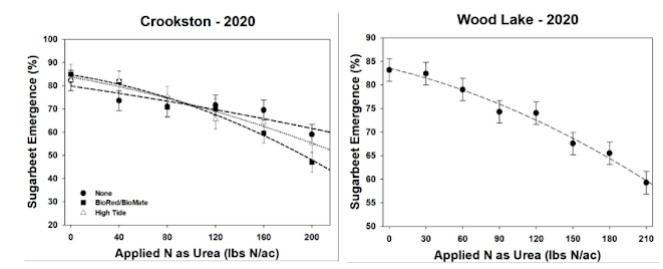By Dan Kaiser
Urea is a common nitrogen (N) fertilizer source for many crops across the state of Minnesota. Sales statistics show that urea is now the most popular N fertilizer source in the state, overtaking anhydrous ammonia in recent years. While storage and handling of urea are safer than anhydrous ammonia, high application rates of urea can present risks to some crops, including reduced emergence in some crops if application rates are too high.
As urea is hydrolyzed in the soil, ammonia is initially formed. High concentrations of ammonia can impact the germination of some crops. While we typically see a greater impact from ammonia from band application of material near the seed, broadcast application could also present a challenge to a crop if it is more sensitive to ammonia.
Is there a link between high application rates of urea and stand loss?
Two research trials were established in 2020 in Minnesota to study the effect of rates of N applied as spring urea ahead of sugar beet in conjunction with two biostimulant products applied in-furrow at the time of planting. It should be noted that the biostimulant products, a combination of two beneficial bacteria sources called Bio Red® and Bio Mate® and a chitosan product called High Tide®, had no effect on sugar beet yield and quality. Those results will not be discussed in detail in this blog post.
In both trials, urea was surface-applied and incorporated with a field cultivator prior to planting. One field trial was established in the southern growing region near Wood Lake, with eight N rates ranging from zero to 210 pounds per acre. In the northern growing region, a site was established at Crookston with six N rates ranging from zero to 200 pounds per acre.

Figure 1. Effect of nitrogen applied as spring urea on sugar beet emergence at two Minnesota locations during the 2020 growing season.
The above figures summarize the sugar beet emergence data. In both cases, emergence decreased as N rate increased. The biostiumant data are included in the Crookston graph as there was some evidence of a greater decrease in emergence when the biostimulants were applied with higher rates of urea. The higher N rate reduced emergence by roughly 20% at both locations. The relative decrease in emergence increased as N rate increased. This data show that spring urea application can negatively impact sugar beet emergence.
Does decreased emergence affect sugar beet yield and quality?
The answer to this question is no. At both locations, the addition of N fertilizer increased sugar beet root yield. In both cases, the increase in root yield was proportionally greater than the reduction in emergence caused by the application of urea. For example, maximum root yield was achieved with a total of 81 pounds of N as a combination of spring urea and the amount of nitrate-N in a four foot soil sample and did not change when more N fertilizer was applied. Yet, emergence continued to decrease.
So why wasn’t root yield negatively impacted?
The answer lies in the capacity of the crop to flex growth to match population density. In our study, average root size increased due to less competition between plants, resulting in no net effect on yield and no impact on recoverable sucrose per acre.
Should sugar beet growers be concerned with stand loss due to the application of urea?
Only if the variety planted does not adjust growth as population decreases. The main concern for growers is that the consistency of the size among sugar beets is more variable across the field with reduced stand. If the stand is variable with different sized beets, the grower will have a more difficult time setting the machines for defoliating and harvesting the field, which could increase harvest loss.
Can anything be done to reduce the risk for stand loss?
The trials in 2020 only compared multiple rates of urea applied in the spring, and the reduction in emergence is consistent with other research in the Northern and Southern Minnesota growing regions. Additional trials have been established for the 2021 crop-year at locations in the southern and northern growing regions to compare rates of urea applied in the fall and the spring, along with comparisons of ESN and multiple sources of urea products treated with inhibitors. We will be looking at emergence in 2021 with this data.
Source : umn.edu